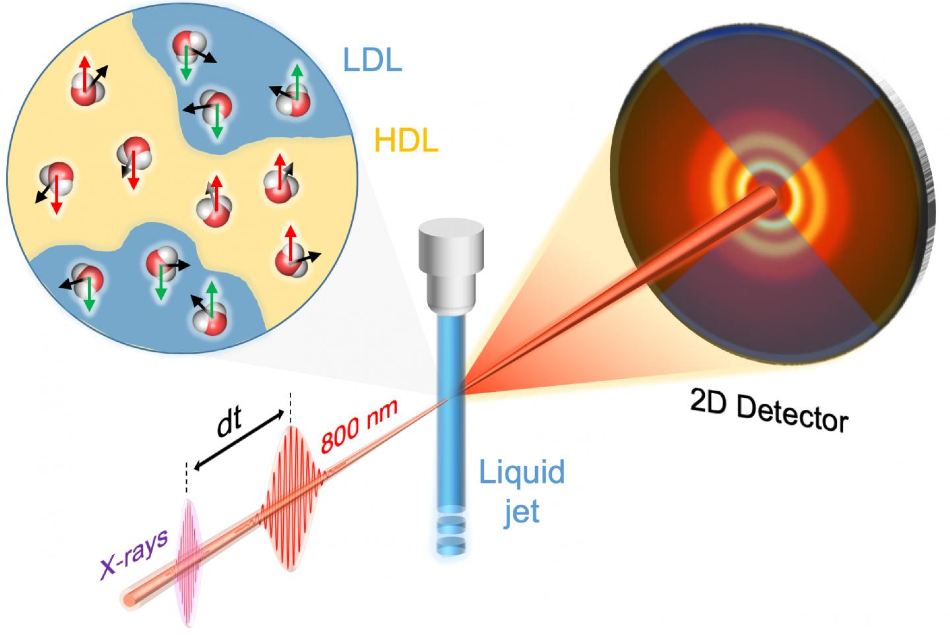Aug 12 2020
At Stockholm University, researchers have identified that water can have similar behavior as that of a liquid crystal upon illumination with laser light.
 The schematic of the experiment used to capture the alignment of water molecules by the laser light. By using X-ray lasers, scientists have seen that the water molecules can be aligned for a very short time, forming a liquid crystal. Water molecules that are in a low-density liquid (LDL—blue regions) are easier to align that those in a high-density liquid (HDL—yellow regions). Image Credit: Fivos Perakis.
The schematic of the experiment used to capture the alignment of water molecules by the laser light. By using X-ray lasers, scientists have seen that the water molecules can be aligned for a very short time, forming a liquid crystal. Water molecules that are in a low-density liquid (LDL—blue regions) are easier to align that those in a high-density liquid (HDL—yellow regions). Image Credit: Fivos Perakis.
This effect is caused by the alignment of the water molecules, which present a combination of low- and high-density domains that are more or less inclined to align. The study findings were published in the Physical Review Letters journal on August 11th, 2020, and were achieved using a combination of experimental studies with molecular simulations and X-ray lasers.
When liquid crystals were first discovered in 1888, they were only regarded as a scientific wonder. More than a century later, they are one of the most extensively utilized technologies, found in digital displays (LCDs) of computer screens, TVs, and watches.
Liquid crystals function when an electric field is applied, which leads to the alignment of nearby molecules in a liquid such that it looks similar to a crystal. Even water can be distorted into a liquid crystal upon illumination with laser light.
It is well-known that the laser’s electric field can lead to the alignment of the water molecules within a billionth of a second. Can this breakthrough find technological applications in the future?
At the Stockholm University’s Physics Department, an international group of researchers conducted experiments at Japan’s X-ray Free-electron laser SACLA and explored, for the first time, the dynamics of transiently aligned molecules by making use of X-ray pulses.
This method is based on the orientation of the molecules with a laser pulse (with a wavelength of λ = 800 nm) and probing the alignment with X-ray pulses. This enables the researchers to observe the variations in the structure on a molecular level in real time. By modifying the time between the laser and the X-ray pulses, the team could resolve the aligned state, which endures only for 160 fs.
It is known that the water molecules are aligned due to the polarization of the laser pulse. it is a unique capability however to be able to use X-ray lasers to see the molecular alignment in real time.
Kyung Hwan Kim, Former Researcher, Stockholm University
Kim is currently working as an assistant professor at POSTECH University in Korea.
X-rays are perfect for probing molecules because their wavelength matches the molecular lengthscales. I really enjoy having the opportunity to use state-of-the-art X-ray facilities to investigate fundamental questions that could have future technological applications.
Dr Alexander Späh, Postdoc, Stanford University
Dr Späh was formerly a PhD student in Physics at Stockholm University.
The experiments were reproduced well using molecular simulations, which provided an understanding of the basic alignment mechanism. By presuming that water acts like a two-state liquid, having high- and low-density liquid (HDL and LDL) domains, the team identified that every domain exhibits a different tendency to align.
Water molecules in the LDL regions have stronger hydrogen bond network, which makes the molecules easier to respond to the strong laser field. It would be fascinating to measure the lifetime of the molecular alignment in the supercooled regime, where everything is expected to slow down dramatically.
Anders Nilsson, Professor in Chemical Physics, Stockholm University
“Being able to understand water on a molecular level by watching the changes of the hydrogen-bond network, can play a major role in biological activity” says Fivos Perakis, assistant professor in Physics at Stockholm University. “I am curious to see whether the observed alignment can lead to technological applications in the future, for example in connection to water cleaning and desalination.”
Journal Reference
Kim, K. H., et al. (2020) Anisotropic X-Ray Scattering of Transiently Oriented Water. Physical Review Letters. doi.org/10.1103/PhysRevLett.125.076002.